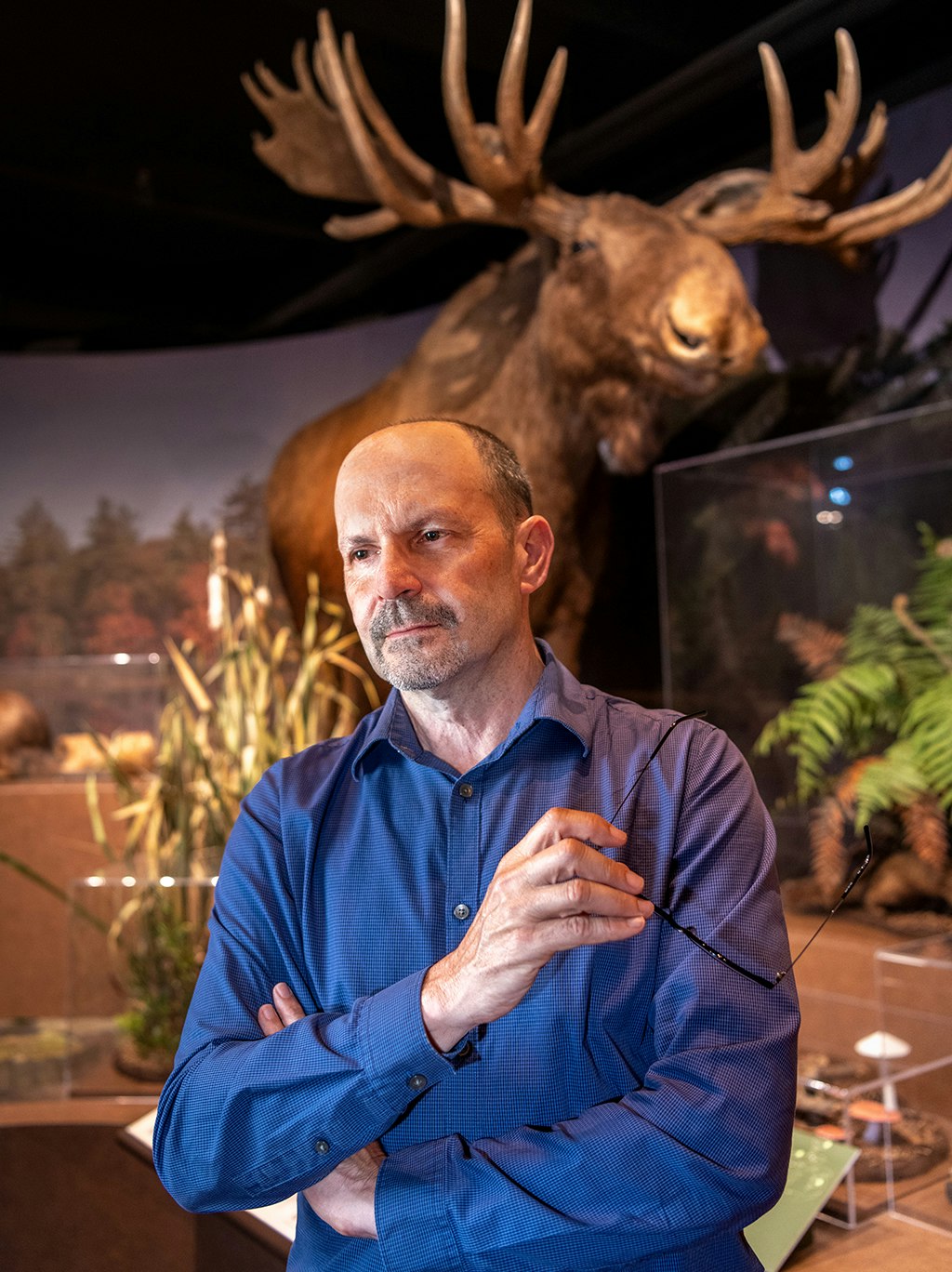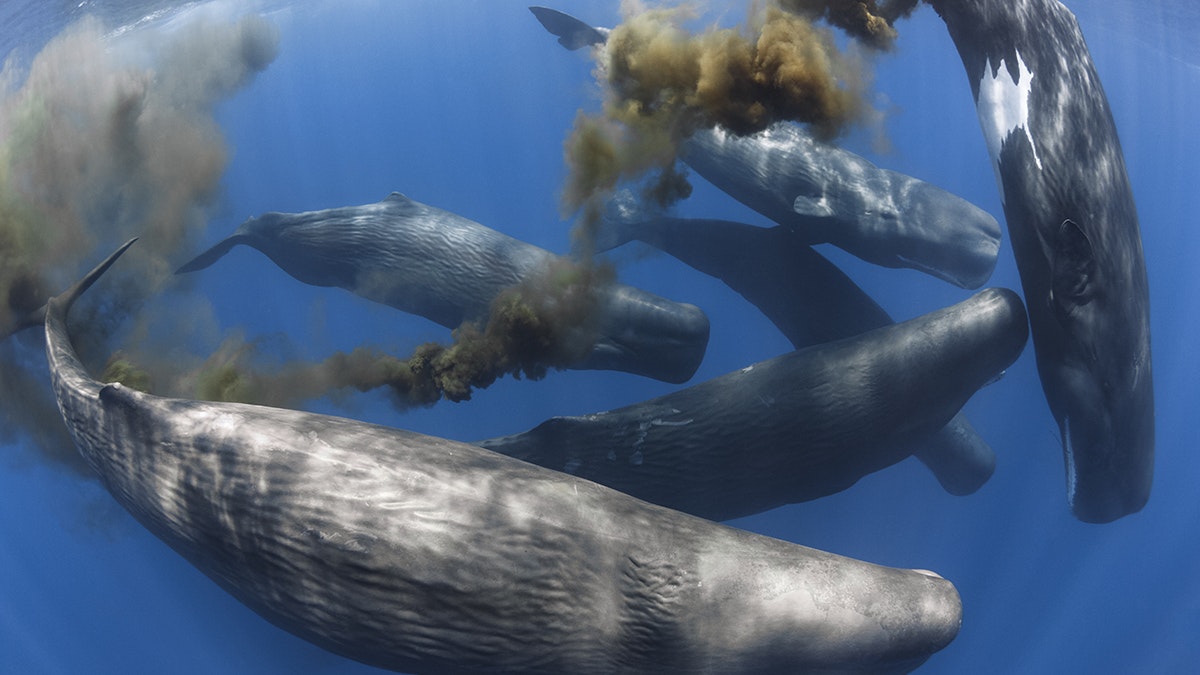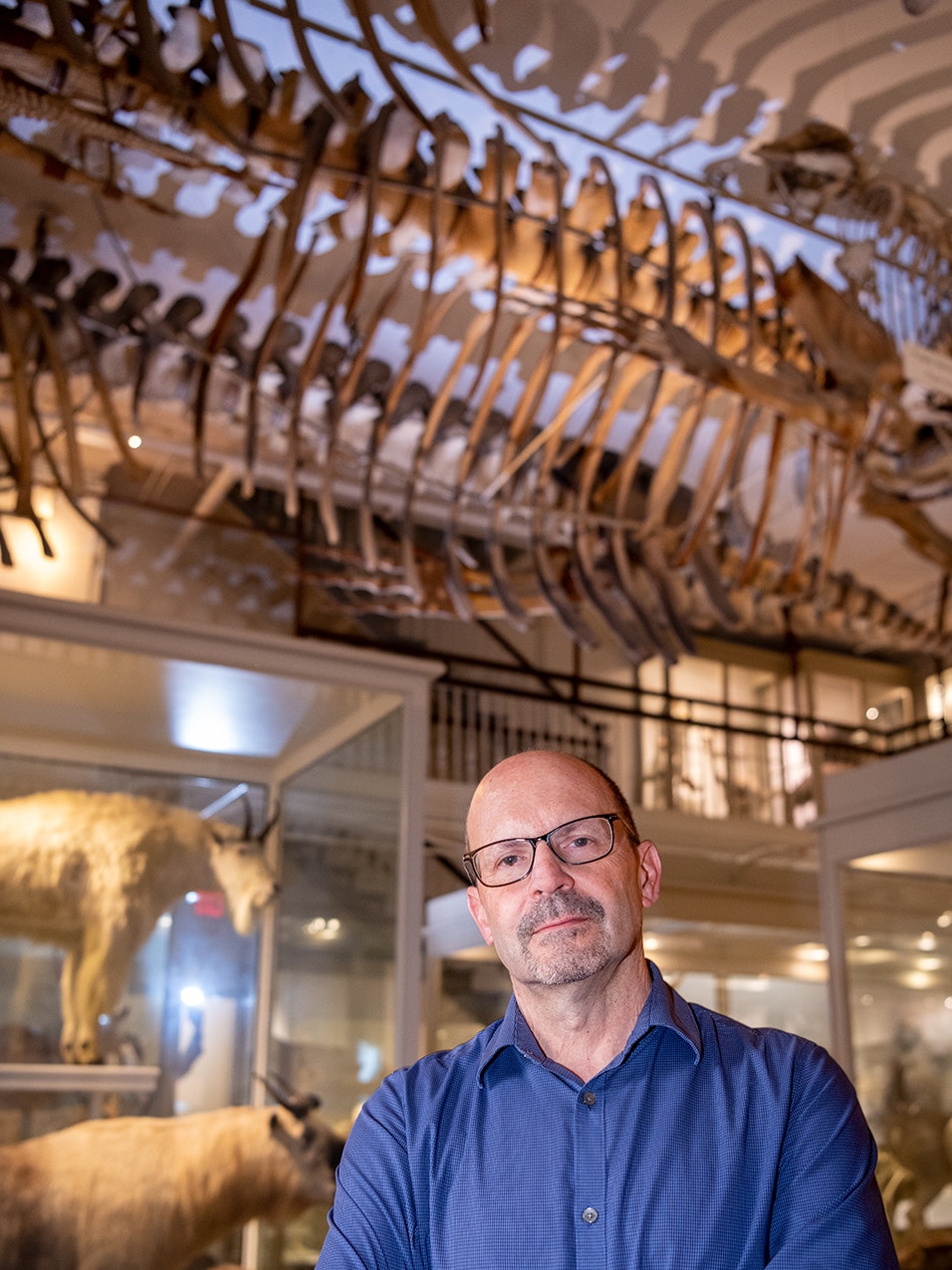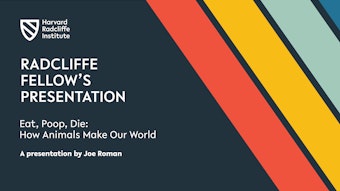The Circle of Life

The conservation biologist Joe Roman highlights the importance of animals in shaping our environment.
It was 2019 and Joe Roman ’85, PhD ’03, RI ’23 was in Iceland on the last leg of a Fulbright research project when he suddenly grasped the primal nature of his life’s work.
“I was putting together a slide for my final talk, and I realized I’d spent most of my career on how animals eat, poop, and die,” he recalls. “It was as basic as that.”
The University of Vermont conservation biologist’s latest book of the same name explores that crucial trinity and its impact on mother earth.
As a 2022–2023 Radcliffe fellow, Roman is finishing up his manuscript and hoping his efforts—like his earlier research, teaching, and writing—will help raise awareness and inspire the kind of love of living creatures that drives him. He likens animals to the planet’s circulatory system, moving “nutrients around the globe” and profoundly shaping our environment in the process. “Animals,” he argues, “are the overlooked part of the system.”
Roman’s journey here took a circuitous route, with numerous stops at Harvard along the way.
Born in Queens, Roman grew up in Long Island, where he developed an early fascination with nearby salt marshes. As a teen, he spent weekends with Audubon Club septuagenarians traipsing through fields, forests, and wetlands in search of osprey and snowy owls. Eager to curb litter and restore wildlife to area parks, the young Roman even began a letter writing campaign to local officials. He now admits his youthful desire to repopulate a local playground with roving mountain lions wasn’t “the most practical” idea.
“I would look at encyclopedias and find all the animals that used to live on Long Island and dream of how to restore them,” he says.
But that interest in protecting and preserving animals and their habitats never left him.

“I realized I’d spent most of my career on how animals eat, poop, and die. It was as basic as that,” says Roman. Here, a sperm whale fecal plume in the South Pacific. Photo by Tony Wu
A visual and environmental studies concentrator at Harvard College, Roman worked in film and publishing after graduation, but his freelance editing and writing jobs always left him eager to get outdoors. He volunteered then worked for the New York City Audubon Society in the Jamaica Bay Wildlife Refuge, leading a cleanup effort of nearby salt marshes and teaching a salt marsh ecology class. That’s when something clicked.
“To live in Manhattan and take the subway to a wildlife preserve to see ospreys, peregrine falcons, horseshoe crabs, and nesting diamondback terrapins all within New York City, it was a cause for wonder. Even in a large city, close to where I grew up, we could have a relatively thriving ecosystem.
“That was really the spark. I was still working as a writer and editor, but I got more excited about being out in the field and teaching and learning about coastal habitats. And I realized that was how I could be involved in conservation more directly,” says Roman.
With his new goal to help “reduce the number of extinctions on the planet” in whatever small way he could, he headed back to school.
Roman received his master’s degree in wildlife ecology and conservation at the University of Florida in 1997. Soon after, he returned to Harvard, where he received his PhD in organismic and evolutionary biology in 2003. For his dissertation, Roman compared the genetic diversity of whale populations past and present and used genetics to better understand how the European green crab arrived on American shores and worked its way from Cape Cod to Nova Scotia. One of the most invasive marine species in the world, the small green crustacean poses a serious threat to seagrass and marsh habitats and can wreak havoc on other species, particularly smaller shore crabs, clams, and small oysters.
Through the years, Roman has learned to balance his enthusiasm with concern. He credits the return of certain whale, seal, and wolf populations that were once close to extinction to important laws such as the Marine Mammal Protection Act, the Endangered Species Act, and the Clean Water Act. But he knows that for many other animals, including the Gulf of Mexico whale, which was devastated by the Deepwater Horizon oil spill, time is running out.
“That is part of the motivation behind my work, a concern that some species could go extinct during our lifetimes or in the very near future,” says Roman.
In that spirit, Roman’s three books are all variations on the same theme: the beauty and frailty of nature. In his book Whale (Reaktion Books, 2006), the author and researcher explores the history of whales and whaling. His book Listed: Dispatches from America’s Endangered Species Act (Harvard University Press, 2011) examines the sweeping law passed in 1973 to help protect at-risk species from extinction. The book looks at how the law reduced the extinction rate in the United States and changed the way the nation manages endangered species for the better. But it also examines some of its shortcomings, including a lack of adequate funding and protections for critical habitats for endangered animals and plants.
His latest book again makes the case for wild animals.
In “Eat, Poop, Die,” Roman is eager for readers to appreciate the importance and beauty of animals and their key role in supporting Earth’s ecosystems. “Too often,” he says, “animals are viewed as consumers, but they can also build ecosystems from scratch.” In his pages, he points to the example of a new island that was formed off Iceland after a series of volcanic eruptions in 1960s, and how biologists followed the arrival of new life on the barren landscape.
Gradually the island Surtsey, named after the Nordic giant of fire, became a living lab, allowing scientists to watch as the birds’ droppings fertilized the soil. Today, they’ve created a vibrant meadow that has become the gulls’ primary nesting ground, and their presence supports a range of animal and plant life across the island.
“That’s a nice straightforward story of animals making a difference in one particular ecosystem,” says Roman, whose new book gives a range of creatures—from bison to midges to whales—their due.
And then there is the Brood X cicada. In the spirit of the late Harvard biologist E. O. Wilson, perhaps the world’s greatest ant champion, Roman is hoping to reframe the reputation of the large insects with big red eyes, transparent wings, and impossibly loud song. They emerge every 17 years in the billions and are considered by some to be a Bible-like blight. But in his new book, Roman recasts them as benefactors, highlighting how the insects spend nearly two decades underground releasing nutrients from the root systems they feed on back to the forest floor, supporting and nurturing other animals and plant life.
It makes sense that whales also figure prominently in Roman’s latest work. The scientist has studied the ocean giants for years and the role they play in maintaining marine ecosystems. Certain species have made stunning comebacks over the past century, including humpback whales, which were nearly hunted to extinction until the US Marine Mammal Protection Act in 1972 and a later international moratorium on commercial whaling helped jumpstart their recovery. And while whaling nations including Japan, Iceland, and Norway have complained that restored whale populations harm fish stocks in their coastal waters, Roman’s research suggests whales can help keep fish numbers healthy for everyone. The nutrient-rich fecal plumes whales release at the ocean’s surface help fuel phytoplankton, the microscopic marine algae that consume carbon dioxide and release oxygen.
“Our work shows whales affect primary productivity,” said Roman. “They can boost the growth of phytoplankton in the oceans, and that increases the number of zooplankton, which can increase the number of fish and the number of whales.”
In addition, when whales die and their carcasses fall to the ocean floor, the carbon stored in their massive bodies can stay sequestered for centuries. Their remains also help feed a host of deep-sea creatures.

This graphic from Roman's forthcoming paper in Trends in Ecology & Evolution shows the great whale conveyor belt, an indirect carbon pathway depicting nutrient and carbon fluxes between humpback whale feeding and breeding grounds in the North Pacific Ocean. Nutrients released on the breeding grounds are assumed to be new nutrients in the system, thus stimulating new primary production, carbon export, and carbon sequestration. Illustration by Alex Boersma
Roman describes this cyclical process as the “whale pump,” a concept that crystalized for him while he was pursuing his doctoral degree at Harvard and working closely with James J. McCarthy, an oceanographer, a professor, and the former director of the University’s Museum of Comparative Zoology.
“Jim was one of the first people to entertain my quirky idea that whales might matter, and he also had the skill set to analyze how these ideas might work.” They released their first paper in 2010. Numerous others followed.
But writing books and research papers are just some of the ways Roman is trying to help highlight conservation success stories while sounding the alarm about looming extinctions and habitat loss driven by man and by nature.
Over the past several years, he has been promoting a proposal to close the military prison at the US Naval Station Guantánamo Bay, or Gitmo, and repurpose the facilities into a “state-of-the art marine research center and peace park” that can both aid diplomacy and address the “challenges of climate change, mass extinction, and declining coral reefs.” In 2016, Roman and his coauthor James Kraska published an article in Science outlining their plans, and they continue to engage former government officials about ways to make their dream a reality. He also founded Eat the Invaders, a website that promotes “invasive species recipes.”

The looming possibility of animal extinction partly motivates Roman's work. Photo by Lou Jones
In a similar vein, Roman’s newest book celebrates natural diversity and conservation and how wild animals help keep the natural world’s balance in check. It is also harshly realistic, noting that domestic animals make up 60 percent of the biomass of all mammals on earth; humans represent about 36 percent, and all wild mammals, including elephants and whales, just 4 percent. Animal agriculture is responsible for about 15 percent of the world’s annual greenhouse gas emissions.
Roman knows that the most important step in combating climate change is reducing the amount of carbon humans release into the atmosphere. At the same time, he says, we should also focus on natural processes to sequester carbon, removing carbon dioxide through whale falls in the deep sea, or the restoration of wild animals to their natural habitats on land. This natural approach will not only help balance levels of nitrogen, carbon, and phosphorous in the environment but also unite people around a common ecological wonder.
“I bet you 1,000 years ago animals were like the weather. If you walked out of your home, you would see animals all around, whether they were birds, fish, bears, or insects, and you would talk about all the things you saw with your friends and family. They would be commonplace. And I think that could happen again.
“It's not that different from the ideas in E. O. Wilson’s book Half Earth, which argues that half of the planet should be devoted to the natural world. In my last chapter, I reflect on what an earth would look like where animals were again roaming around. How would that influence the ecosystem? How would that influence us?”
Roman is pragmatic about the challenges ahead, but he points out the hope in recent conservation success stories such as that of humpback whales and northern elephant seals, which are thriving today after being on the verge of extinction.
“I grew up in New York with a critical view of the world,” says Roman. “But I just happened to work on whales during my career, and against all odds, many whale populations are doing great. So I have real cause for optimism, probably against my own nature, that things can turn around.”
Colleen Walsh is a freelance writer.








